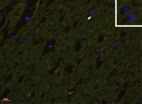(Press-News.org) SEATTLE – Male DNA is commonly found in the brains of women, most likely derived from prior pregnancy with a male fetus, according to first-of-its-kind research conducted at Fred Hutchinson Cancer Research Center. While the medical implications of male DNA and male cells in the brain are unknown, studies of other kinds of microchimerism – the harboring of genetic material and cells that were exchanged between fetus and mother during pregnancy – have linked the phenomenon to autoimmune diseases and cancer, sometimes for better and other times for worse.
The study findings are published Sept. 26 in PLOS ONE. Lead author William F. N. Chan, Ph.D., in the Department of Biochemistry at the University of Alberta, conducted the research while working in the Hutchinson Center laboratory of J. Lee Nelson, M.D., a member of the Center's Clinical Research Division and a leading international authority on microchimerism. Nelson is senior author on the paper.
Chan said the study is the first description of male microchimerism in the female human brain. The findings support the likelihood that fetal cells frequently cross the human blood-brain barrier and that microchimerism in the brain is relatively common. Until this study, it was not known whether these cells could cross the barrier in humans.
For this research, scientists examined brain autopsy specimens from 59 women who had died between the ages of 32 and 101. Male microchimerism was detected in 63 percent of subjects, was distributed in multiple brain regions and was potentially persistent throughout the human lifespan; the oldest female in whom male fetal DNA was detected in the brain was 94.
Twenty six of the women had no neurological disease and 33 had Alzheimer's disease. The brains of women with Alzheimer's had a somewhat lower prevalence of male microchimerism, which appeared in lower concentrations in regions of the brain most affected by the disease. However, the authors noted that the small number of subjects and largely unknown pregnancy history of the women means a link between Alzheimer's disease and level of male cells of fetal origin cannot be established.
The study also does not provide an association between male microchimerism in the female brain and relative health versus disease. "Currently, the biological significance of harboring male DNA and male cells in the human brain requires further investigation," Chan said.
However, other Hutchinson Center studies of male microchimerism in women have found it to impact a woman's risk of developing some types of cancer and autoimmune disease. In some conditions, such as breast cancer, cells of fetal origin are thought to confer protection; in others, such as colon cancer, they have been associated with increased risk. Hutchinson Center studies also have linked lower risk of rheumatoid arthritis to women who previously had given birth at least once as compared to nulliparous women.
###
Grants from the National Institutes of Health and the Canadian Institutes of Health Research funded the study, which also involved researchers from the Department of Pathology and Division of Rheumatology at the University of Washington School of Medicine.
Editor's note: To obtain a copy of the PLOS ONE paper, "Male Microchimerism in the Human Female Brain," please contact Dean Forbes in media relations at the Hutchinson Center, dforbes@fhcrc.org or 206-667-2896.
At Fred Hutchinson Cancer Research Center interdisciplinary teams of world-renowned scientists – including three Nobel laureates – seek new and innovative ways to prevent, diagnose and treat cancer, HIV/AIDS and other life-threatening diseases. The Hutchinson Center's pioneering work in bone marrow transplantation led to the development of immunotherapy, which harnesses the power of the immune system to treat cancer with minimal side effects. An independent, nonprofit research institute based in Seattle, the Hutchinson Center houses the nation's first and largest cancer prevention research program, as well as the clinical coordinating center of the Women's Health Initiative and the international headquarters of the HIV Vaccine Trials Network. Private contributions are essential for enabling Hutchinson Center scientists to explore novel research opportunities that lead to important medical breakthroughs. For more information visit www.fhcrc.org or follow the Hutchinson Center on Facebook, Twitter or YouTube.
CONTACT
Dean Forbes
206-667-2896
dforbes@fhcrc.org
Men on the mind: Study finds male DNA in women's brains
2012-09-27
ELSE PRESS RELEASES FROM THIS DATE:
Pregnancy generates maternal immune-suppressive cells that protect the fetus
2012-09-27
A new study published online in the journal Nature suggests it might be possible to develop vaccines to prevent premature birth and other pregnancy complications. If so, such vaccines would be the first intended to stimulate the subset of regulatory CD4 T cells that suppress the immune response.
Current vaccines are specifically designed to stimulate T cell subsets that activate the immune response.
The study, led by a researcher at Cincinnati Children's Hospital Medical Center, shows the immune system of a pregnant mother stimulates cells that selectively prevent ...
Researchers define 2 categories of multiple sclerosis patients
2012-09-27
BOSTON, MA—There are approximately 400,000 people in the United States with multiple sclerosis. Worldwide, the number jumps to more than 2.1 million people. Rather than a one-size-fits-all approach to treating the millions with multiple sclerosis, what if doctors could categorize patients to create more personalized treatments? A new study by researchers at Brigham and Women's Hospital (BWH) may one day make this idea a reality in the fight against the debilitating autoimmune disease.
A research team led by Philip De Jager, MD, PhD, BWH Department of Neurology, senior ...
Touch-sensitive tentacles catapult prey into carnivorous plant traps
2012-09-27
Swift predators are common in the animal world but are rare in the plant kingdom. New research shows that Drosera glanduligera, a small sundew from southern Australia, deploys one of the fastest and most spectacular trapping mechanisms known among carnivorous plants.
The study, published Sep. 26 in the open access journal PLOS ONE, is a collaboration between the Plant Biomechanics Group at the University of Freiburg and private sundew cultivators from Weil am Rhein, and provides the first experimental demonstration of fast-moving snap tentacles in sundew plants propelling ...
Large 2012 earthquake triggered temblors worldwide for nearly a week
2012-09-27
This year's largest earthquake, a magnitude 8.6 temblor on April 11 centered in the East Indian Ocean off Sumatra, did little damage, but it triggered quakes around the world for at least a week, according to a new analysis by seismologists from the University of California, Berkeley, and the U.S. Geological Survey (USGS).
The April 11 quake was unusually large – the tenth largest in the last 100 years and, similar to a few other recent large quakes, triggered small quakes during the three hours it took for seismic waves to travel through Earth's crust.
The new study ...
Cannabis withdrawal symptoms might have clinical importance
2012-09-27
Cannabis users have a greater chance of relapse to cannabis use when they experience certain withdrawal symptoms, according to research published Sep. 26 in the open access journal PLOS ONE led by David Allsop of the National Cannabis Prevention and Information Centre (NCPIC) at the University of New South Wales.
The authors tested a group of dependent cannabis users over a two week period of abstinence for impairment related to their withdrawal symptoms. Findings were correlated with the probability of relapse to cannabis use during the abstinence period, and the level ...
First evidence of fetal DNA persisting in human brain tissue
2012-09-27
Small portions of male DNA, most likely left over in a mother's body by a male fetus can be detected in the maternal brain relatively frequently, according to a report published Sep. 26 in the open access journal PLOS ONE by William Chan of Fred Hutchinson Cancer Research Center and his colleagues.
The process, called fetal 'microchimerism (Mc)', is common in other tissues such as blood, but this is the first evidence of male Mc in the human female brain. Microchimerism can be both beneficial and harmful to maternal health, since it is associated with processes such ...
Viewing gender-specific objects influences perception of gender identity
2012-09-27
Spending too much time looking at high heels may influence how a viewer perceives the gender of an androgynous face, according to new research published Sep. 26 in the open access journal PLOS ONE by Amir Homayoun Javadi of Technische Universität, Dresden and his colleagues. The study sheds new light on how the objects surrounding us may influence our perceptions of gender.
The authors found that when people view objects highly associated with one gender, like high heels for women or electric shavers for men, for a short period of time and are then asked to identify the ...
Psychology of equine performance and the biology behind laminitis
2012-09-27
Achieving the best performance from a horse is the goal of not just professional riders, but also the millions of amateur and hobby riders all over the world. A new article published in BioMed Central's open access journal BMC Veterinary Research looks at the issues surrounding training, competition environment and practices, and how the psychology of horse mood, emotion and temperament can be used to enhance performance. A sister article looks at the devastating disease laminitis, and finds that the anti-inflammatory protein apolipoprotein A-IV (APOA-IV) is raised in chronic ...
Scientists make old muscles young again in attempt to combat aging
2012-09-27
An international team of scientists have identified for the first time a key factor responsible for declining muscle repair during ageing, and discovered how to halt the process in mice with a common drug. Although an early study, the findings provide clues as to how muscles lose mass with age, which can result in weakness that affects mobility and may cause falls.
The study, to be published in the journal Nature, involved researchers from King's College London, Harvard University and Massachusetts General Hospital.
The study looked at stem cells found inside muscle ...
TB drug could reduce mortality for MDR-TB and XDR-TB cases
2012-09-27
Results from an observational study evaluating a new anti-TB drug have found that the treatment can improve outcomes and reduce mortality among patients with both MDR-TB and XDR-TB.
The research, published online ahead of print today (27 September 2012) in the European Respiratory Journal, suggests a drug called delamanid could have a public health benefit for MDR-TB and also for XDR-TB, as few effective treatment options are currently available.
Over the past two decades, multidrug-resistant TB (MDR-TB) has emerged as a significant public health threat, with strains ...





